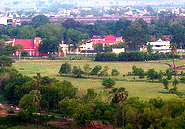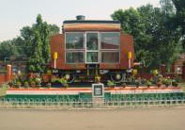Welcome to Jamalpur the world’s most beautiful place! Munger, Bihar
Welcome to Jamalpur ||Munger, BiharArchive for History Of Jamalpur
Railway Colonies in India by John Alton Price
When quite a child in India I had gathered, from the odd word I happened to overhear, or the odd attitude one observed when the subject of Railways was mentioned there seemed to be an antipathy towards ‘those Railway people’. I found this somewhat mysterious and puzzling : however, not being in contact with any of the Railway Colony; they lived in the extreme north of Delhi and we were housed in the south or ‘Posh’ area as some saw it. I also remember being told to stay clear of the area where they lived. This rather upset me and I thought the attitude was somewhat curious, not to say unfair. I found out as I grew older and a bit more knowledgeable that the Railway people were considered a bit ‘Racy’ and not quite up to the mark or shall we say a bit common. In much later days I was to discover for myself that these opinions were positively unfair and rather, or downright ignorant. I had in my ‘growing up’ days had very little contact with railway people in India, except for the occasional meeting through rail travel.During my service in the Military I was to be Posted to a quite important Railway Station called Jamalpur, in Bihar. Read the rest of this entry »
Anglo-Indian Day Celebration Combines the Best of British and Indian Cultures Through Film, Books, Music, and Food
New York, NY – August 1, 2010. The presence of the British in India gave rise to a sub-culture that flourished for the better part of three centuries. The Anglo-Indians, a hybrid people of Indian and European descent, carved a unique niche for themselves in British India.

While their language, religion, and educational background were European, they developed a style of life that borrowed from both their British and Indian progenitors but jelled into something that was essentially their own. After India gained Independence in 1947, the majority of the Anglo-Indian community emigrated to the UK, Australia, and Canada.

Book reading and discussion by Blair Williams and author Margaret Deefholts
Today, their children and grandchildren no longer have any psychological or emotional ties with India. In addition, most of these early Anglo-Indian emigrants are now elderly, and there is little doubt that their cultural heritage will, within a generation or two, be extinguished forever.

Ambassador Prabhu Dayal during book reading and discussion
Ambassador Prabhu Dayal, the Indian Consul General, hosted an event on Sunday, August 1, 2010, to celebrate “Anglo-Indian Day” in New York City, along with the Indo-American Arts Council (IAAC) and the Calcutta Tiljallah Relief (CTR). Experience the film, music, food, and culture of Anglo-Indians on Sunday, August 1 at the Indian Consulate on the Upper East Side, the event took place at the grand ballroom of the former mansion on 64th and Fifth, built in 1903 for Ms. Carrie Astor.
“The IAAC serves as a platform to expose New Yorkers to Indian art, films, books, and music, and we recognize the Anglo-Indian community as a part of our rich, Indian culture,” says Executive Director Aroon Shivdasani. “Anglo-Indians are one more ingredient in New York’s giant melting pot, and we hope this celebration creates awareness about the Anglo-Indian community.”

6 books on the Anglo-Indian culture for sale at the event
In 2002 a publishing company was launched, to capture the Anglo-Indian culture. The guidelines stated that “these publications, will depict our Anglo-Indian way of life, and will cover a broad contemporary canvas. We would like to capture not only who we were but how we were in all walks of life—the way we lived, worked, rejoiced, loved, laughed, and cried.”

Book reading by author Margaret Deefholts
Six book have been published since:
“Anglo-Indians. Vanishing remnants of a bygone era” – Blair Williams (2002)
“Haunting India” – Margaret Deefholts (2003)
“Voices on the Verandah. Anglo-Indian Prose and Poetry” – Edited Margaret Deefholts and Sylvia Staub (2004)
“The Way We Were. Anglo-Indian Chronicles” – Edited Margaret Deefholts and Glen Deefholts (2006)
“The Way We Are. An Anglo-Indian Mosaic” – Edited Lionel Lumb and Debbie Van Veldhuizen (2008)
“Women of Anglo-India. Tales and Memoirs” – Edited Margaret Deefholts and Susan Deefholts (2010)

The publication of these books have another vitally important and synergistic function: The gross proceeds of all sales—publishing costs are borne privately—will go directly to CTR Inc, an IRS approved charity helping less fortunate Anglo-Indians in India. The series thus serves a dual purpose: to preserve the culture of the Community and to provide much needed resources for its poorer members in India.
“The Anglo-Indian community, in its modern sense, is a distinct, small minority community originating in India whose British ancestry was bequeathed paternally,” says Blair Williams, Founder of CTR, a New York-based non-profit organization that provides education and support to the Anglo-Indians living around the world. “While there is a small number of us living and working in New York, this day is a way for us to share our culture and sensibilities with the larger community.”
The schedule for the celebration is as follows:
3 to 5 p.m. – Brief Welcome Statements and screening of Aparna Sen’s 36 Chowringee Lane, a film that explores the solitary life of an Anglo-Indian woman living in Calcutta.
5:15 to 6:30 p.m. – Book reading and discussion by Blair Williams and author Margaret Deefholts.
6:30 to 9 p.m. – Cocktails, dinner, and dancing with Consul General’s address at 7 p.m.

Distinguished guest dance to playing music by Anglo-Indian singers such as Cliff Richards, Englebert Humperdink, Tom Jones and others.

Indo-American Arts Council Founder and Executive Director Aroon Shivdasani sharing a casual moment with Ambassador Prabhu Dayal, the Indian Consul General

Indo-American Arts Council Founder and Executive Director Aroon Shivdasani with friends

ITV interviewed Deputy Speaker of New Jersey General Assembly Upendra Chivukula at the event

Blair Williams, Aroon and Ambassador Prabhu Dayal, the Indian Consul General

Author Margaret Deefholts with Aroon

Judy Menon, Assistant Director of the Consul General’s Office
About Indo-American Arts Council: The Indo-American Arts Council is a registered 501(c)3 not-for-profit, secular service and resource arts organization charged with the mission of promoting and building the awareness, creation, production, exhibition, publication and performance of Indian and cross-cultural art forms in North America. www.iaac.us
About CTR: Founded by Blair Williams CTR is a U-S based non-profit organization established in 1999, whose sole purpose is to help the indigent Anglo-Indians living in India. CTR raises funds for senior pensions and education of Anglo-Indians. For more information about the organization, please visit http://www.blairrw.org/ctr/index.php.
Photo Credits to Julian Williams and Indo-American Arts Council
On Jamalpur – Anglo-Indian Railway Officers
By Blair Williams
Jamalpur is best known as a very large workshop on the East Indian Railway, employing at one time, over 12,000 persons and over 1000 Anglo-Indians. Jamalpur was overnight from Calcutta and was famous for its Anglo-Indian social life. The Railway Institute was huge – it had its own movie theatre, a six-lane swimming pool, four tennis courts, two billiard rooms and a bowling lawn. Its dances were renowned and railway folk came from all over EIR to attend.

I do not think of JAMALPUR as a city..I think of it as a railway colony …bungalow dwellings …and Happy Valley
By Yvonne Eva Le Fort
[aka:Yvonne Hussein Le Fort at Facebook]
I do not think of JMP as a city..I think of it as a railway colony …bungalow dwellings …and Happy
valley was the place for picnics and group outings .NO tall buildings like Notre Dame Scjhool in current pictures .The offices of the EIR Works directly across from 14 Victoria Rd were not more than two storey IF my memory serves me right .
Going to school 5000′ above sea level at Jharipani then returning to JMP for holiday periods where was there any mountain in JMP? Intriguing …there were rolling hills at Happy Valley…and somewere not that far away we went to hotsprings near a river that had alligators in it …we were not allowed to go swimming in it. Read the rest of this entry »















